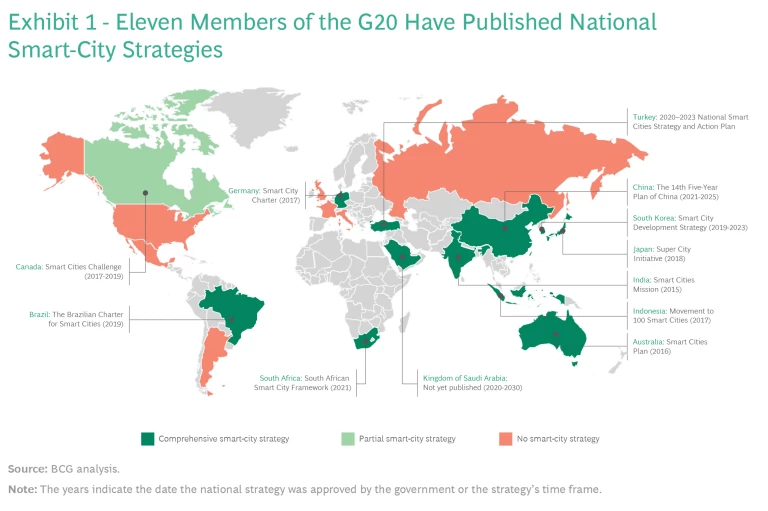Fifty-five percent of the world’s population currently lives in urban areas, a proportion that is expected to increase to 68% by midcentury, according to the UN-Habitat’s World Cities Report 2022. The trend toward greater urbanization puts pressure on governments to ensure that cities remain livable, sustainable, and vibrant.
Fortunately, a new breed of so-called smart cities—such as London, Riyadh, and Seoul—are meeting the challenge by weaving digital technologies into the fabric of urban existence. By integrating artificial intelligence (AI), sensors, and other cutting-edge technologies into their core services, these and other smart cities are redefining how residents, businesses, and governments will live, interact, and operate in the coming years.
Megacities are leading the way, and their efforts foreshadow the gains that can be made by cities around the world. By studying the initiatives of smart cities and regions, other urban centers can learn to manage—if not alleviate—issues such as overcrowding, gridlock, safety, and water shortages. For instance, through its Energy Atlas project, Amsterdam gathers and analyzes energy data from buildings, infrastructure, and its transportation system to reduce energy consumption and promote the adoption of renewable energy.
The reality, though, is that many cities and regions lack the resources needed to adopt such programs. This is where national governments can make a difference.
How National Governments Can Lead
Over the past decade, many national governments have made great strides with their digital agendas, achieving widespread adoption of digital technology to provide government benefits, conduct transactions, and distribute information. The logical next step is for governments to promote and fund smart-city strategies.
A country that other nations can learn from is South Korea, which created a five-year roadmap in 2019. In the years since, South Korea has been actively financing its national smart-city policy, supporting startups, and creating innovation ecosystems. As a result, the city of Sejong is piloting a system for optimizing transportation flows through an AI-based analysis of traffic flow data. Another city, Busan, is testing a smart-water management system to improve the city’s water use.
National governments can and should also focus on talent and skills, as well as R&D. Here, both Brazil and Germany stand out, as they value enablers such as research institutions and even include them as a key audience to whom strategic recommendations are addressed.

But countries such as South Korea, Germany, and Brazil are still not the norm. A recent BCG analysis found that only 11 of the Group of 20 (G20) member states have published a national smart-city strategy. (See Exhibit 1.) What’s more, most of these advanced nations have yet to publish frameworks, implementation structures, or guidelines for funding.
While many national governments have yet to fully embrace smart cities, they have the tools and know-how to help cities of all sizes become smart. They can play a major role when it comes to creating an enabling regulatory environment, effective governance structures, and balanced financing mechanisms.
A national smart-city strategy is essentially a master plan that guides the evolution of smart cities within a country. It typically includes a vision, core values, and strategic goals, as well as a roadmap outlining the execution and expected impact. The national strategies that exist usually sync with the country’s broader goals—ambitions such as reducing carbon emissions, streamlining transportation flows, or creating a circular economy. National smart-city strategies can also lead to the creation of new economic sectors and aid with the skilling and reskilling of workers. In addition, they can improve satisfaction among the users of government services and increase digital equity among residents and other constituents.
Germany’s stated goal is for smart cities to “promote eco-friendly mobility, energy, heat, water, sewage, and waste concepts and contribute to making municipalities carbon-neutral, green, and healthy.” And Turkey’s smart-city strategy supports its national goal of collaborating with the private sector to build a more skilled workforce, particularly in economically distressed parts of the country. BCG’s analysis of the 11 G20 member nations with a smart-city strategy revealed that all 11 have mobility and energy policies; 9 have education and government policies; 7 have health care, safety, commerce, and resource management policies; and 4 have smart-building policies.
In addition to supporting a country’s policy agenda, a national smart-city strategy can also help a national government measure and benchmark its country’s progress. (See “Turkey’s Smart-City Monitoring System.”)
Turkey’s Smart-City Monitoring System
National governments should prioritize smart-city policies that promote mutually beneficial partnerships between the public and private sectors. Nine of the 11 national smart-city strategies count businesses as relevant stakeholders—and 7 of those also mention startups. However, few federal governments detail how the private sector should be involved in the execution of the national strategy. Two that do are South Korea and Australia. (See “Public-Private Partnerships in South Korea and Australia.”)
Public-Private Partnerships in South Korea and Australia
Australia’s Smart Cities Plan foresees the creation of an infrastructure financing unit with the task of leveraging private sector funding for smart-city measures. The government sees the private sector as key to achieving the plan’s goals of making smart investments in cities’ infrastructure, driving smart-city policies, and using smart technology to improve sustainability and innovation.
For its part, the private sector should be aware of the business opportunities that exist in helping governments build smart cities. According to Emergen Research, the global market for smart-city software, hardware, and services is predicted to grow from a little more than $400 billion in 2021 to $1.4 trillion in 2030. Governments can encourage greater participation by industry by creating technical standards, such as transmission protocols that enable interoperability among internet of things devices and solutions that enhance residents’ experiences. Having universal standards helps manufacturers lower their production costs and adopt new standards more quickly. Japan serves as a leader in this area, having introduced rules for ensuring the compatibility of data linkage infrastructure and compliance with safety management standards.

We analyzed the 11 strategies in 12 categories to compare how they are structured, which topics they emphasize, whether they offer financial support, and how they are monitored and implemented. (See Exhibit 2.) In short, national smart-city strategies fare better in high-level categories such as vision and stakeholder engagement, and they seem to focus less on more targeted ones, such as quantitative assessment, KPIs, and monitoring.
Six Strategic Steps
To be sure, building effective national smart-city strategies requires coordinated planning among all levels of government. The following six steps can help national, regional, and local governments achieve the full potential of digital technologies.
Assess the status quo. National government leaders should first conduct a gap analysis of the current smart-city strategies to identify the plan, resources, and funding that each city needs, given its unique characteristics. The analysis should also include linkages to both national and city priorities to ensure alignment and an assessment of the current technology providers and industry players in order to establish the best ways to collaborate with the private sector.
Focus on where the national government can add value. National smart-city strategies should be structured around topics that can be best influenced at the national level . Such topics typically affect multiple industries and usually include regulatory policies, standards, funding, R&D, and digital infrastructure, as well as an assessment of each city’s labor pool.
In addition, national governments should create a regulatory framework that includes national smart-technology guidelines that are transparent and compatible with international standards. The framework should also address potential data issues, including sharing, ownership, amalgamation, compensation, and privacy.
Offer financial support and know-how. National governments should have a dedicated budget for their smart-city strategy. It should provide the funding that’s needed on a national level as well as the financial support that’s necessary on a city and regional level to implement the smart-city agenda.
Leaders should also explore funding their agenda by forging public-private partnerships and instituting environmental externality pricing, such as congestion charges. India, for instance, is allocating $7.48 billion for state and local governments over five years, and each recipient could receive an average of $15.6 million a year; borrowing state governments must provide an equal amount in matching funds.
Nonfinancial support can involve centers of excellence to showcase government and industry know-how and encourage the exchange of knowledge and information. It is essential to create or empower national agencies that can provide the resources, frameworks, and best practices to advance the smart-city agenda.
Create measurable goals. National smart-city strategies are, by nature, broad and ambitious. To ensure long-term success, the defined ambition and scope should be tied to specific KPIs and concrete actions that occur in stages. This allows for the kind of monitoring that creates greater clarity, transparency, and oversight—and, in turn, generates greater impact. Governments should incentivize cities and regions to introduce minimum standards for monitoring the progress of smart-city agendas.
Pick an implementation strategy. Governments should develop a smart-city implementation strategy to ensure that they set the right goals—and that the new services and solution are adopted to drive the targeted outcomes. However, sometimes taking a top-down approach can miss the mark if its needs assessments don’t match local needs. This approach can also err if it approves vendors that lack the technical capabilities to create solutions that meet citizens’ true needs. For these reasons, leaders may want to consider elements of a bottom-up approach, created with broad participation from citizens and other private-sector and government stakeholders.
Refresh the strategy regularly. The burgeoning smart-city movement must adapt to change, with agendas and roadmaps designed accordingly. That means a national strategy should be agile so that it is able to constantly integrate new trends and face challenges, such as a pandemic. It should also integrate lessons from a progressive smart-services rollout and adoption. We are seeing on-going changes in work patterns and emerging technologies as examples of the big challenges for cities—challenges that require coordinated attention on the national level.
As cities worldwide continue to grow and change, the transformation into smart cities is not only desirable but also essential to ensure that urban landscapes are sustainable, adaptable, and livable. The strategies that national governments create can improve cities’ infrastructure, help them deliver services, and foster innovation. The evolution of smart cities will require concerted efforts, strategic planning, and collaboration with diverse stakeholders. But the upside is a future where cities of all sizes become magnets for creativity, harmony, and prosperity.











